Combined Dynamic Time Warping with Multiple Sensors for 3D Gesture Recognition
Abstract
:1. Introduction
2. Gesture Recognition and Dynamic Time Warping
2.1. Gesture Recognition
2.2. Dynamic Time Warping
3. Dynamic Time Warping with Multiple Sensors
3.1. Multiple Sequence Preprocessing
3.2. Viewpoint Weight and Motion Weight
4. Experiments
4.1. Results of the Free-Run Game Gesture
4.2. Results on G3D Gesture
4.3. Time Cost and Comparison with Other Methods.
5. Conclusions/Recommendations
Acknowledgments
Author Contributions
Conflicts of Interest
References
- Essa, I.A. Ubiquitous sensing for smart and aware environments. IEEE Pers. Commun. 2000, 7, 47–49. [Google Scholar] [CrossRef]
- Rautaray, S.S.; Agrawal, A. Vision based hand gesture recognition for human computer interaction: A survey. Artif. Intell. Rev. 2015, 43, 1–54. [Google Scholar] [CrossRef]
- Lun, R.; Zhao, W. A survey of applications and human motion recognition with Microsoft Kinect. Int. J. Pattern Recognit. Artif. Intell. 2015, 29, 1555008. [Google Scholar] [CrossRef]
- Khoshelham, K.; Elberink, S.O. Accuracy and resolution of kinect depth data for indoor mapping applications. Sensors 2012, 12, 1437–1454. [Google Scholar] [CrossRef] [PubMed]
- Galna, B.; Barry, G.; Jackson, D.; Mhiripiri, D.; Olivier, P.; Rochester, L. Accuracy of the Microsoft Kinect sensor for measuring movement in people with Parkinson’s disease. Gait Posture 2014, 39, 1062–1068. [Google Scholar] [CrossRef] [PubMed]
- Borenstein, G. Making Things See: 3D Vision with Kinect, Processing, Arduino, and MakerBot; O’Reilly Media: Sebastopol, CA, USA, 2012. [Google Scholar]
- Kim, J.-H.; Choi, J.S.; Koo, B.-K. Calibration of Multi-Kinect and Multi-Camera Setup for Full 3D Reconstruction. In Proceedings of the 44th International Symposium on Robotics (ISR), Seoul, Korea, 24–26 October 2013; pp. 1–5. [Google Scholar]
- Williamson, B.; LaViola, J.; Roberts, T.; Garrity, P. Multi-kinect tracking for dismounted soldier training. In Proceedings of the Interservice/Industry Training, Simulation, and Education Conference (I/ITSEC), Orlando, FL, USA, 3–6 December 2012; pp. 1727–1735. [Google Scholar]
- Livingston, M.A.; Sebastian, J.; Ai, Z.; Decker, J.W. Performance measurements for the Microsoft Kinect skeleton. In Proceedings of the IEEE Virtual Reality Conference, Costa Mesa, CA, USA, 4–8 March 2012; pp. 119–120. [Google Scholar]
- De Silva, S.; Barlow, M.; Easton, A. An Evaluation of DTW Approaches for Whole-of-Body Gesture Recognition. In Proceedings of the 28th International BCS Human Computer Interaction, Southport, UK, 9–12 September 2014; pp. 11–21. [Google Scholar]
- Sakoe, H.; Chiba, S.; Waibel, A.; Lee, K. Dynamic programming algorithm optimization for spoken word recognition. In Readings in Speech Recognition; Morgan Kaufmann Publishers Inc.: San Francisco, CA, USA, 1990; pp. 159–165. [Google Scholar]
- Lee, H.-K.; Kim, J.-H. An HMM-based threshold model approach for gesture recognition. IEEE Trans. Pattern Anal. Mach. Intell. 1999, 21, 961–973. [Google Scholar]
- Lafferty, J.D.; McCallum, A.; Pereira, F.C.N. Conditional random fields: Probabilistic models for segmenting and labeling sequence data. In Proceedings of the 18th International Conference on Machine Learning, Williamstown, MA, USA, 28 June–1 July 2001; pp. 282–289. [Google Scholar]
- Sakurai, Y.; Yoshikawa, M.; Faloutsos, C. FTW: Fast similarity search under the time warping distance. In Proceedings of the 24th ACM SIGMOD-SIGACT-SIGART Symposium on Principles of Database Systems, Baltimore, MD, USA, 13–15 June 2005; pp. 326–337. [Google Scholar]
- Salvador, S.; Chan, P. Toward accurate dynamic time warping in linear time and space. Intell. Data Anal. 2007, 11, 561–580. [Google Scholar]
- Keogh, E.; Ratanamahatana, C.A. Exact indexing of dynamic time warping. Knowl. Inf. Syst. 2005, 7, 358–386. [Google Scholar] [CrossRef]
- Lemire, D. Faster retrieval with a two-pass dynamic-time-warping lower bound. Pattern Recognit. 2009, 42, 2169–2180. [Google Scholar] [CrossRef] [Green Version]
- Taranta, E.M., II; Simons, T.K.; Sukthankar, R.; Laviola, J.J., Jr. Exploring the Benefits of Context in 3D Gesture Recognition for Game-Based Virtual Environments. ACM Trans. Interact. Intell. Syst. 2015, 5, 1. [Google Scholar] [CrossRef]
- Bloom, V.; Makris, D.; Argyriou, V. G3D: A gaming action dataset and real time action recognition evaluation framework. In Proceedings of the 2012 IEEE Computer Society Conference on Computer Vision and Pattern Recognition Workshops (CVPRW), Providence, RI, USA, 16–21 June 2012; pp. 7–12. [Google Scholar]
- Raheja, J.L.; Minhas, M.; Prashanth, D.; Shah, T.; Chaudhary, A. Robust gesture recognition using Kinect: A comparison between DTW and HMM. Opt.—Int. J. Light Electron Opt. 2015, 126, 1098–1104. [Google Scholar] [CrossRef]
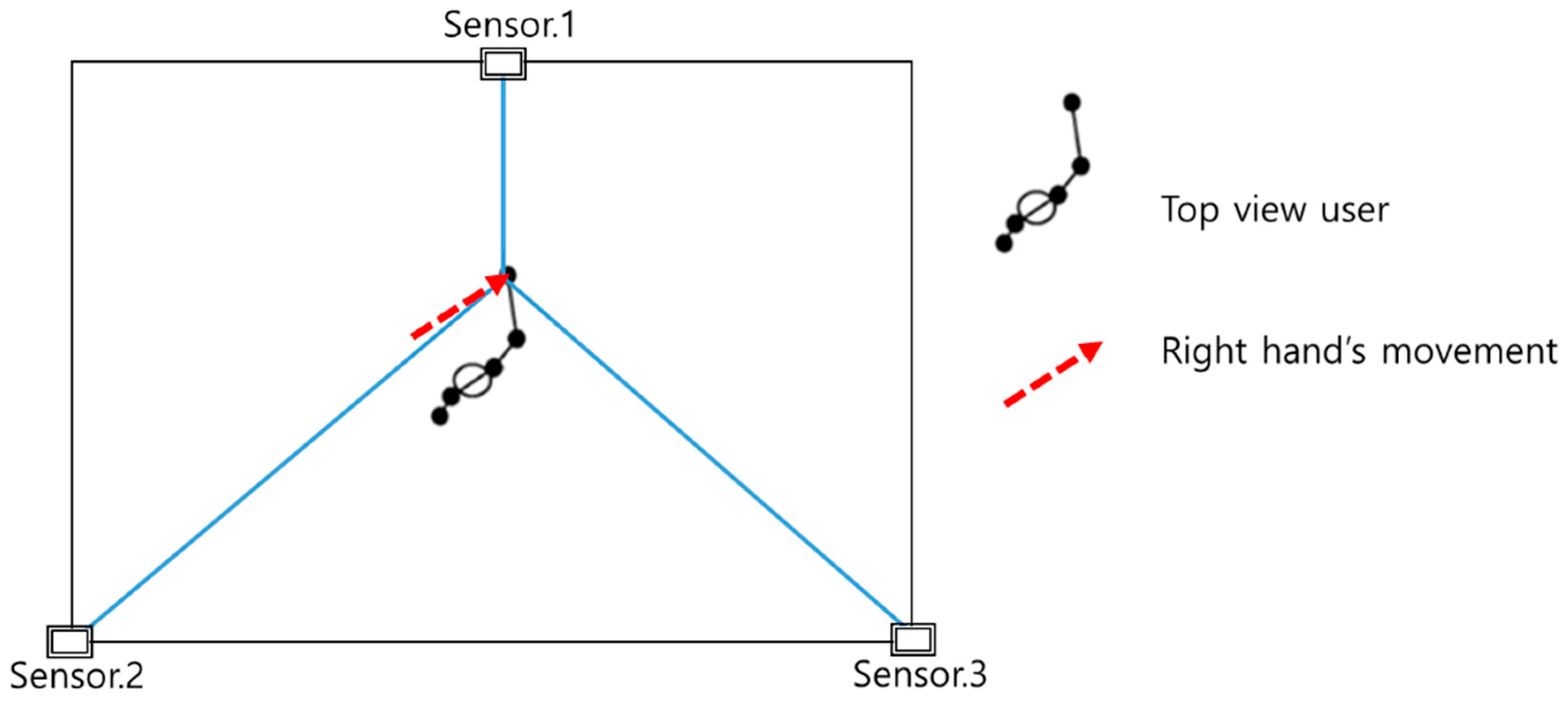
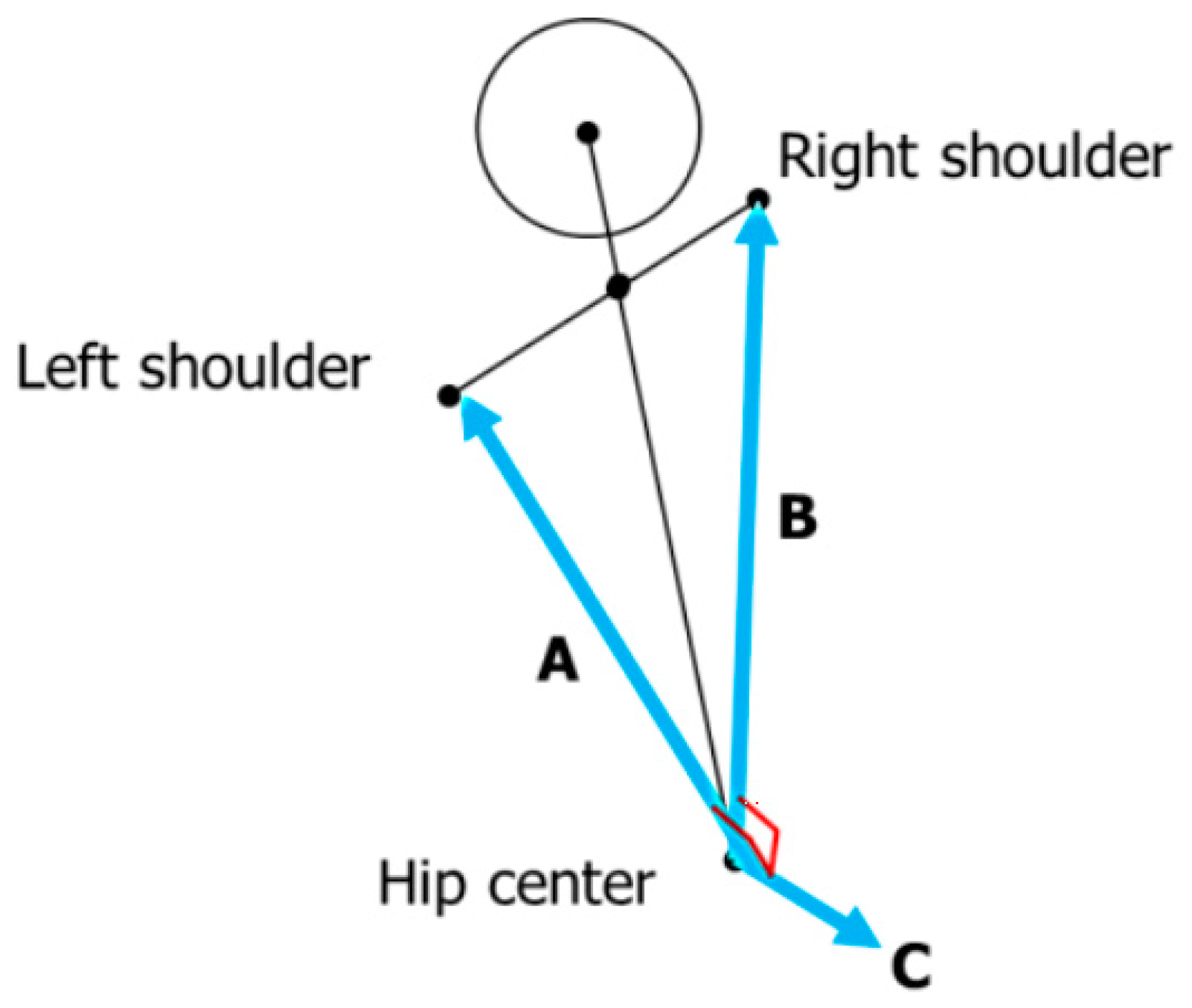
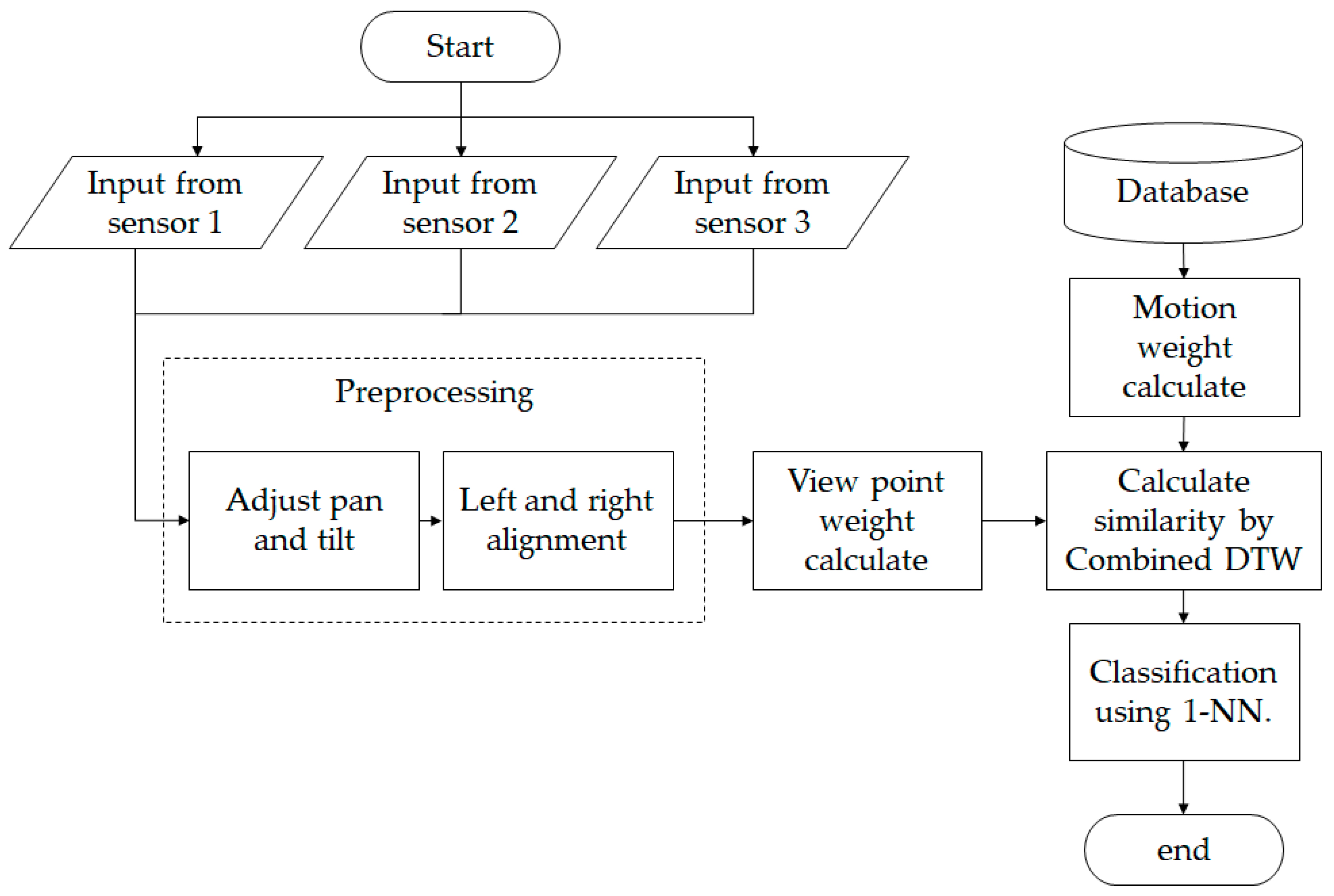

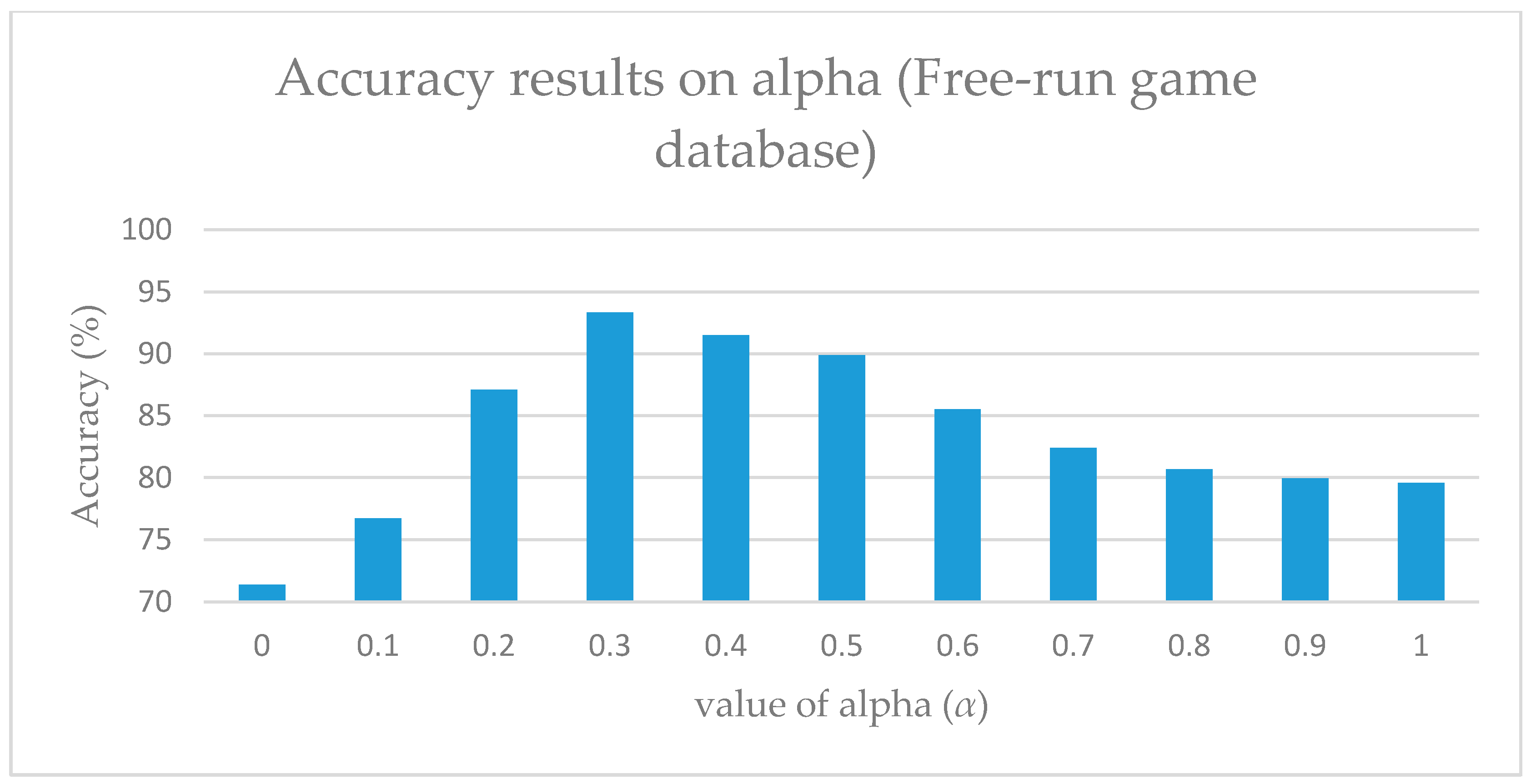
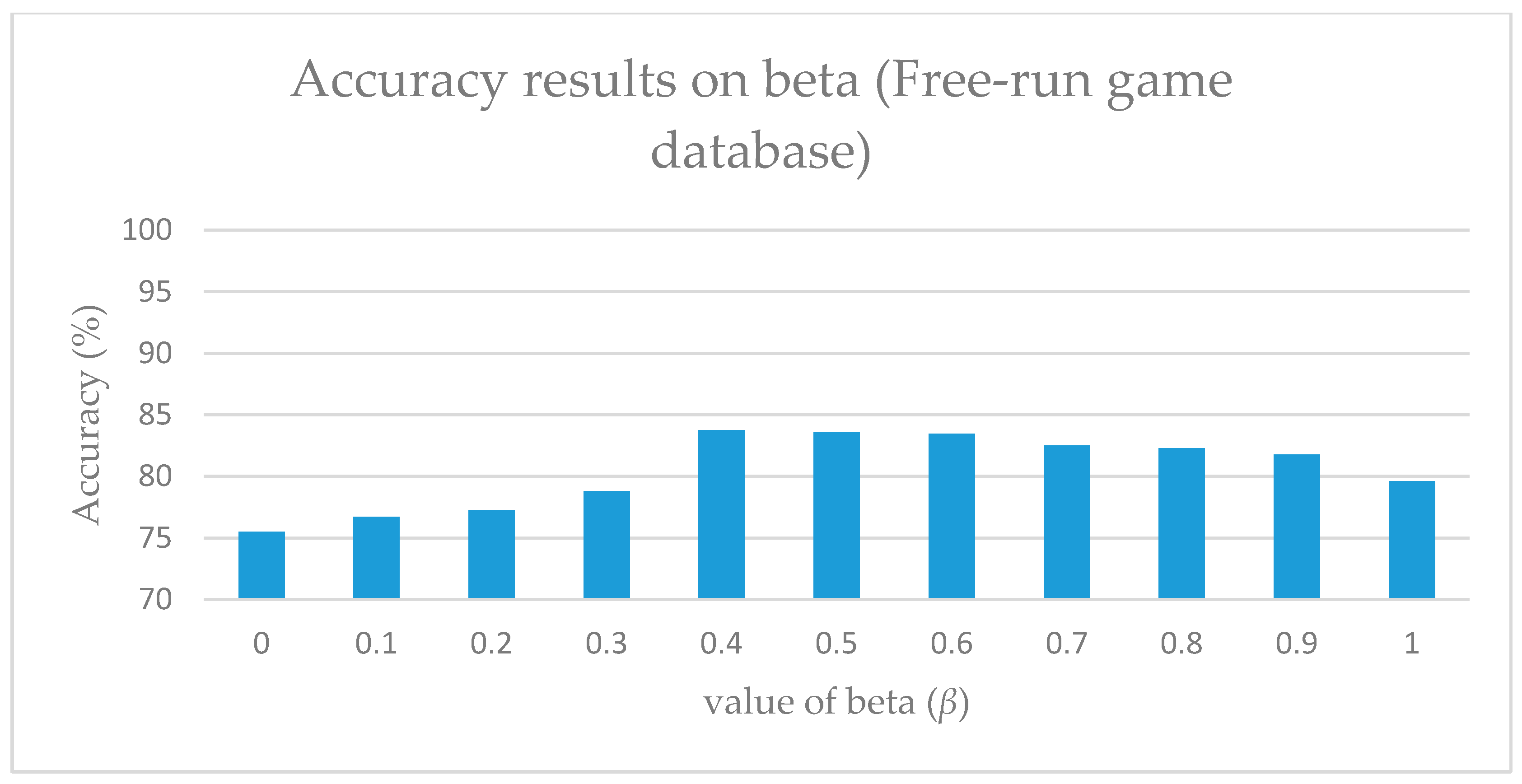
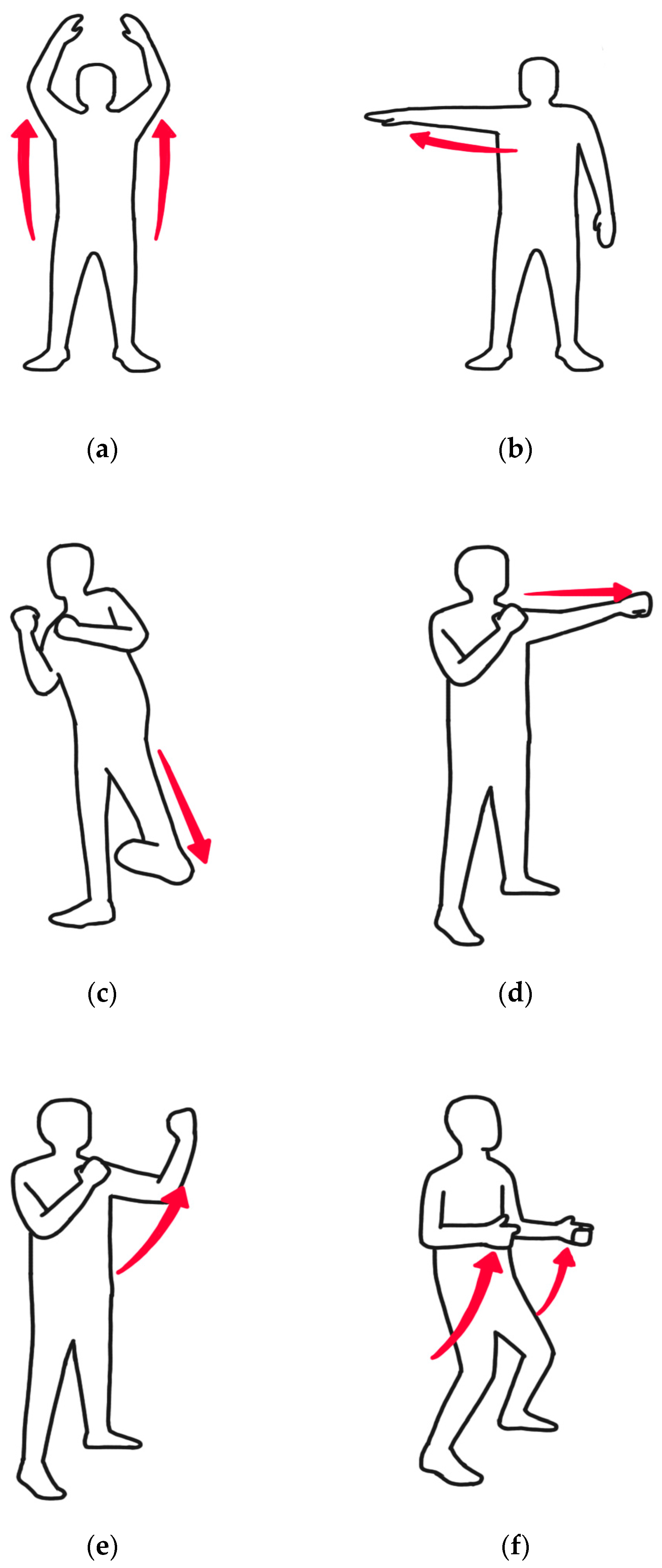
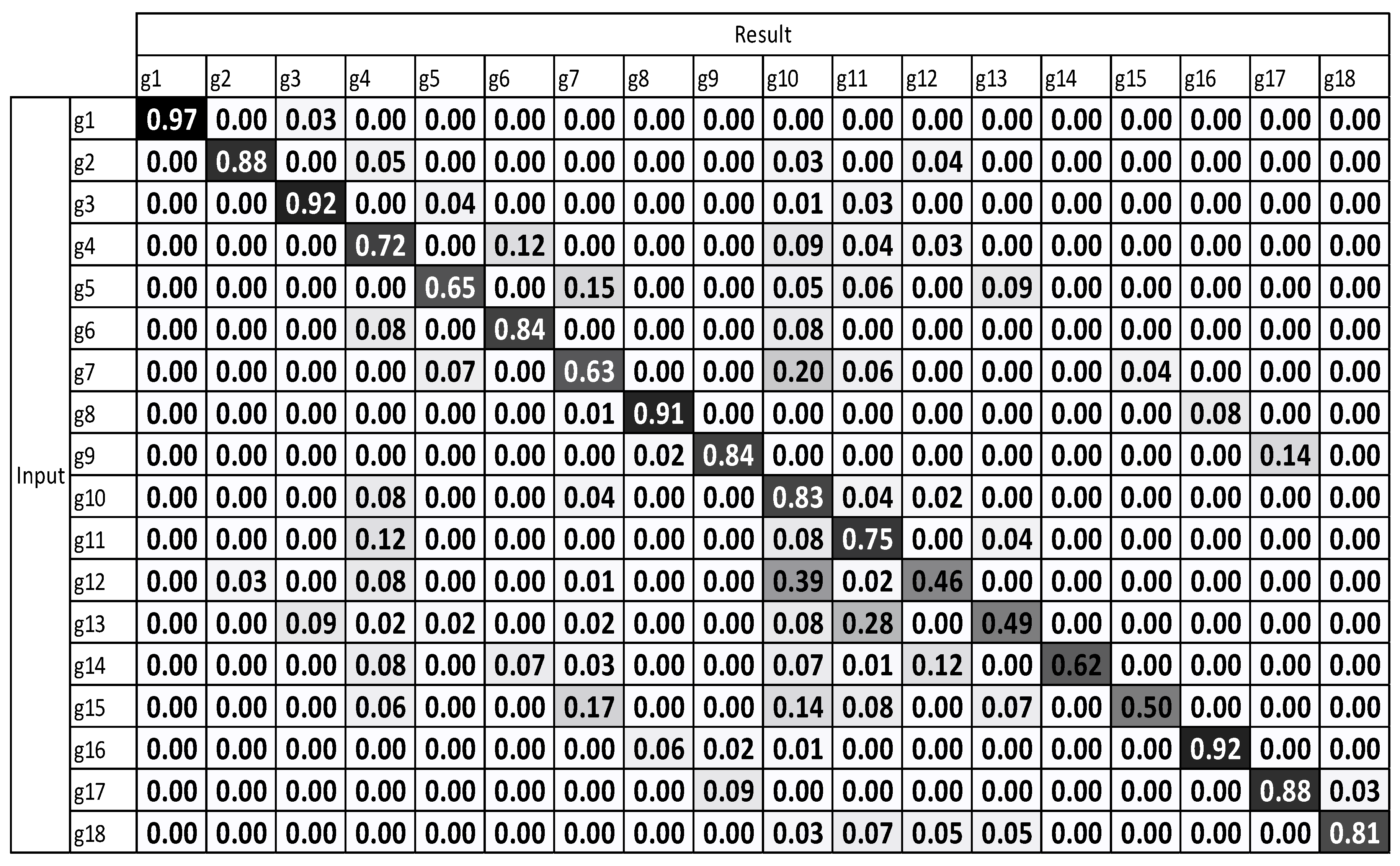
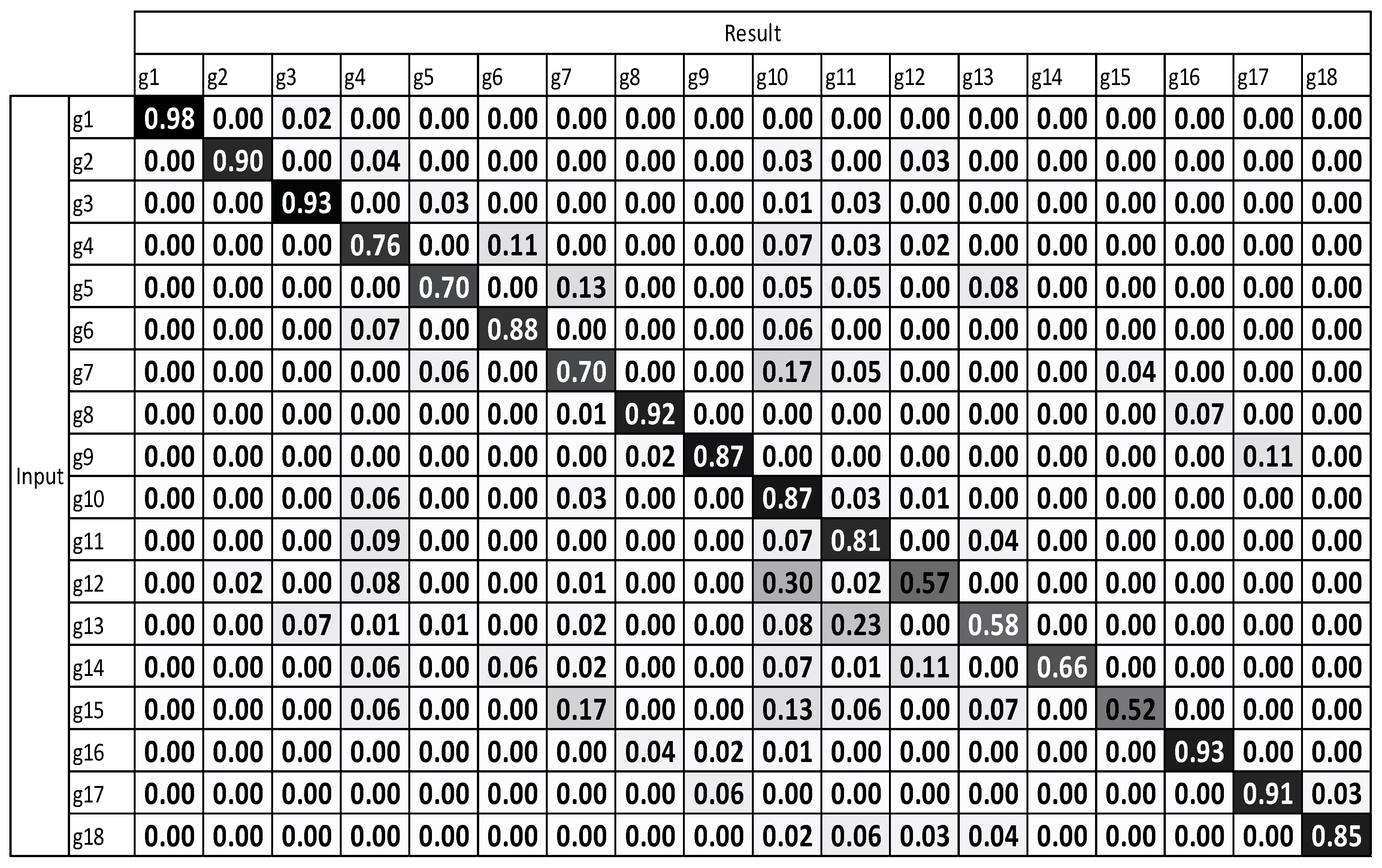

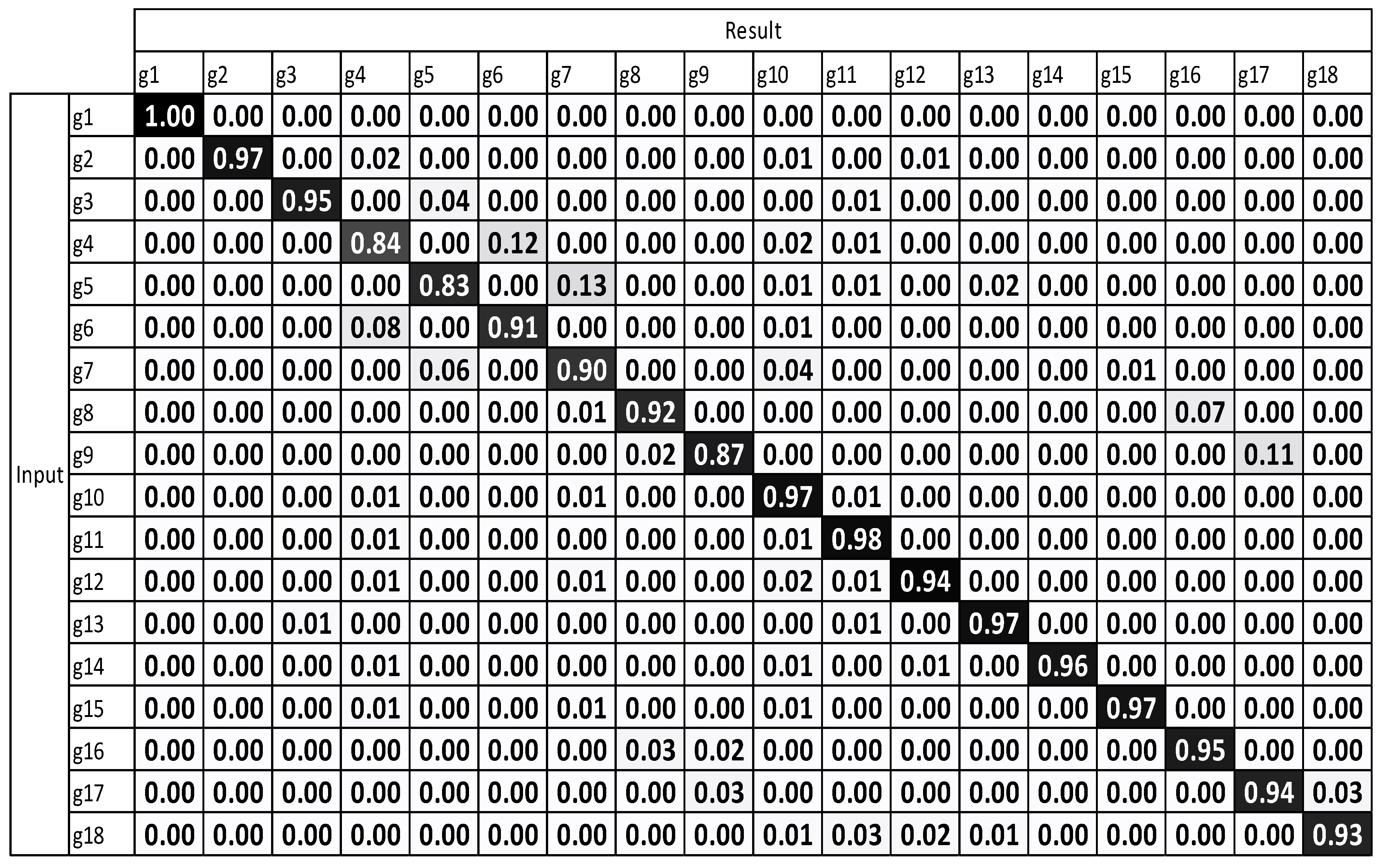

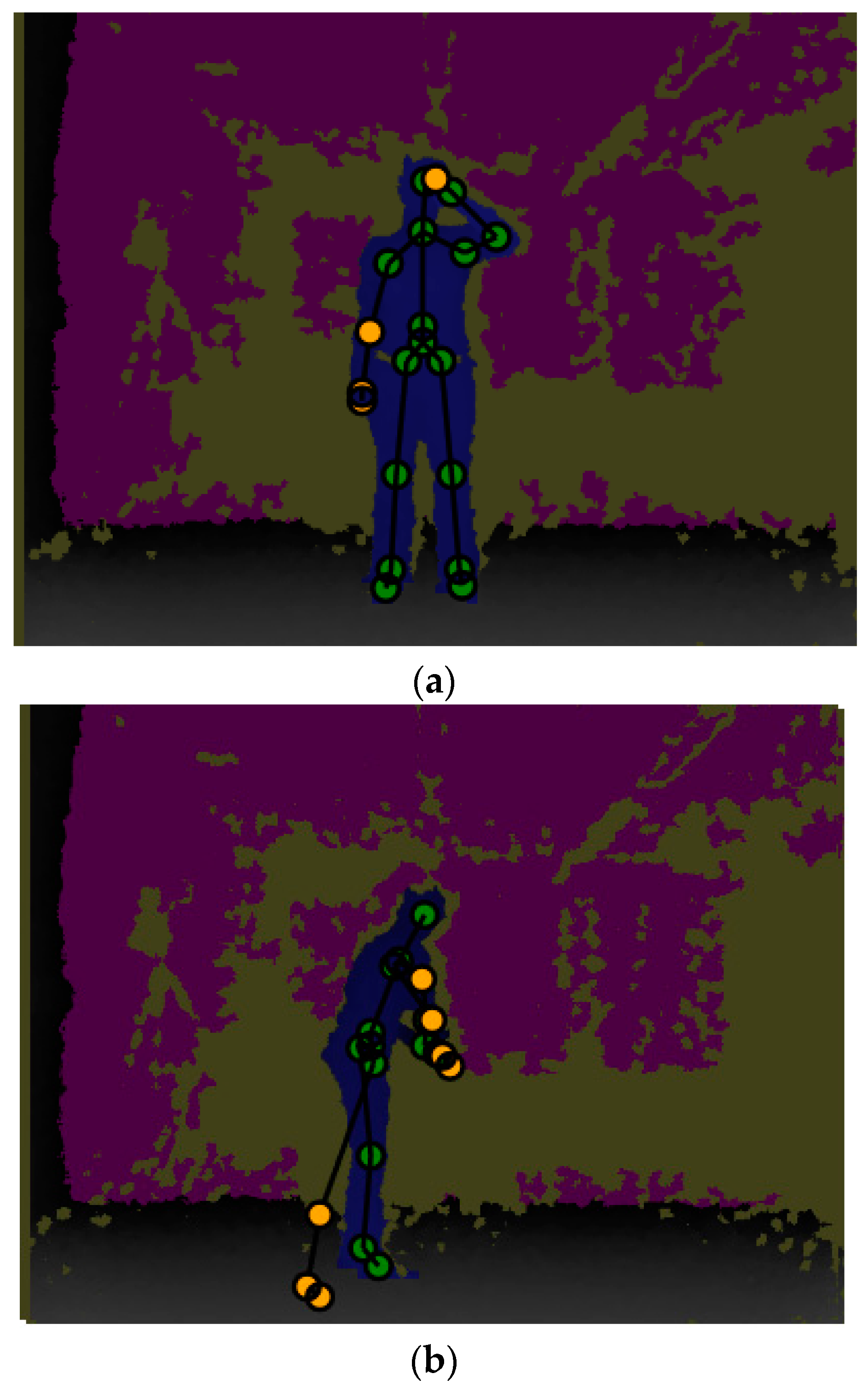
| Database | Standard DTW | DTW with Multiple Sensors | Motion-Weighted DTW | Viewpoint-Weighted DTW | Fully Weighted DTW |
|---|---|---|---|---|---|
| Free-run (18 gestures) | 76.65% | 79.55% | 83.75% | 93.33% | 97.77% |
| G3D (20 gestures) | 69.55% | 73.50% | 81.20% | 89.95% | 92.05% |
| Database | Standard DTW | DTW with Multiple Sensors | Motion-Weighted DTW | Viewpoint-Weighted DTW | Fully Weighted DTW |
|---|---|---|---|---|---|
| Free-run (18 gestures, average number of frames per each gesture is 180) | 4.37 ms | 11.61 ms | 11.69 ms | 29.86 ms | 30.03 ms |
| G3D (20 gestures, average number of frames of each gesture is 90). | 2.86 ms | 7.86 ms | 7.89 ms | 19.41 ms | 19.45 ms |
© 2017 by the authors. Licensee MDPI, Basel, Switzerland. This article is an open access article distributed under the terms and conditions of the Creative Commons Attribution (CC BY) license (http://creativecommons.org/licenses/by/4.0/).
Share and Cite
Choi, H.-R.; Kim, T. Combined Dynamic Time Warping with Multiple Sensors for 3D Gesture Recognition. Sensors 2017, 17, 1893. https://doi.org/10.3390/s17081893
Choi H-R, Kim T. Combined Dynamic Time Warping with Multiple Sensors for 3D Gesture Recognition. Sensors. 2017; 17(8):1893. https://doi.org/10.3390/s17081893
Chicago/Turabian StyleChoi, Hyo-Rim, and TaeYong Kim. 2017. "Combined Dynamic Time Warping with Multiple Sensors for 3D Gesture Recognition" Sensors 17, no. 8: 1893. https://doi.org/10.3390/s17081893





